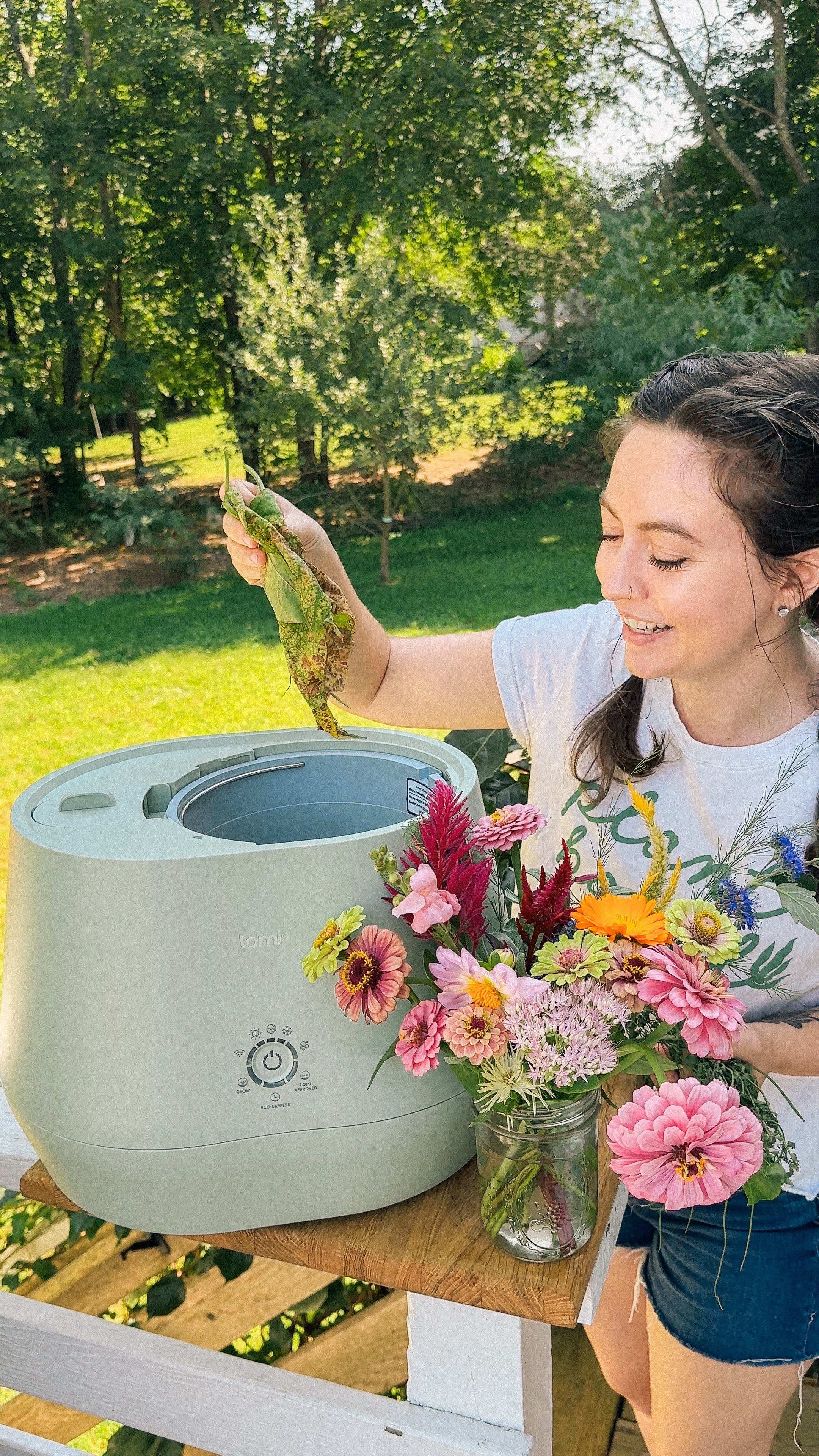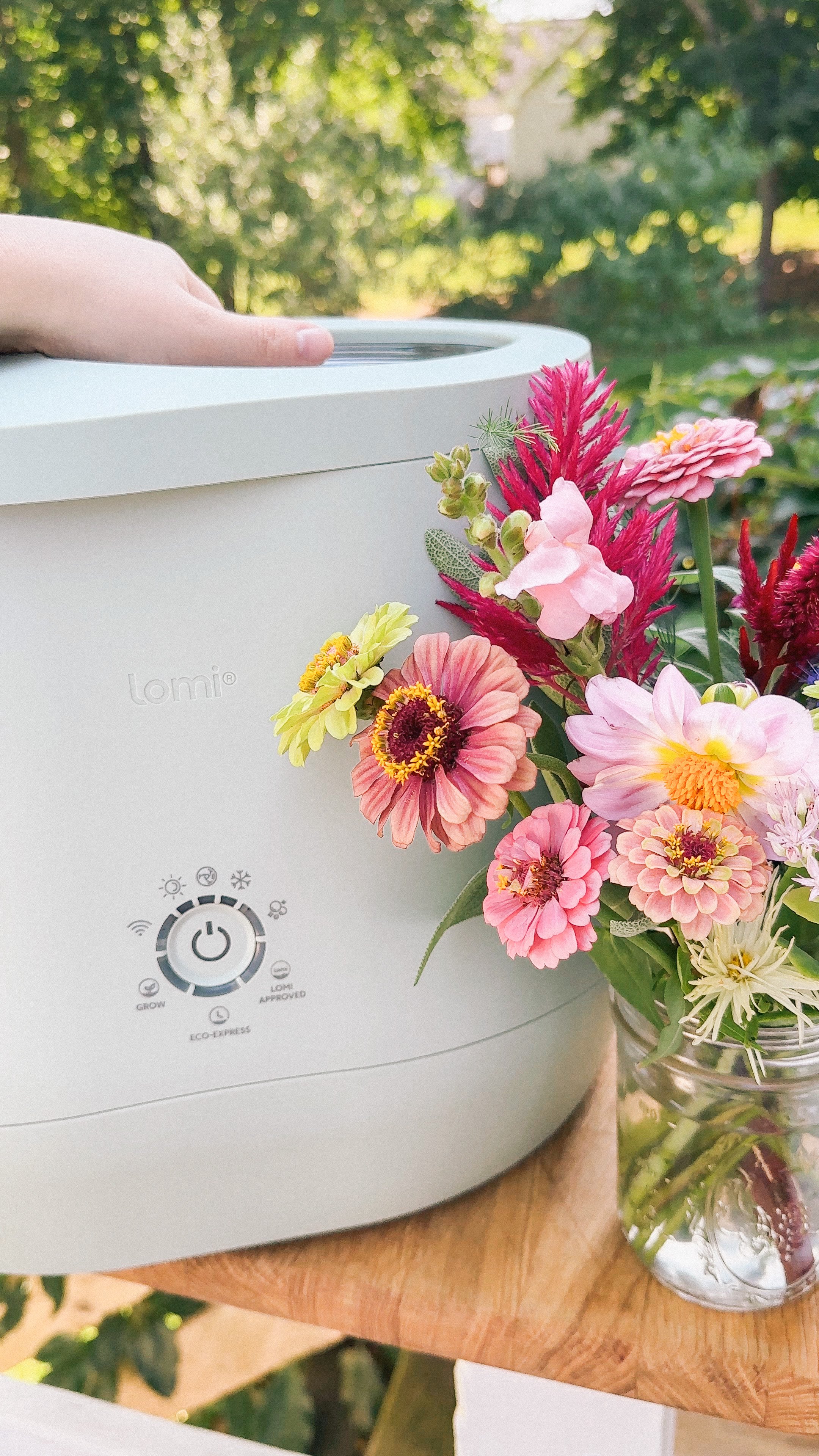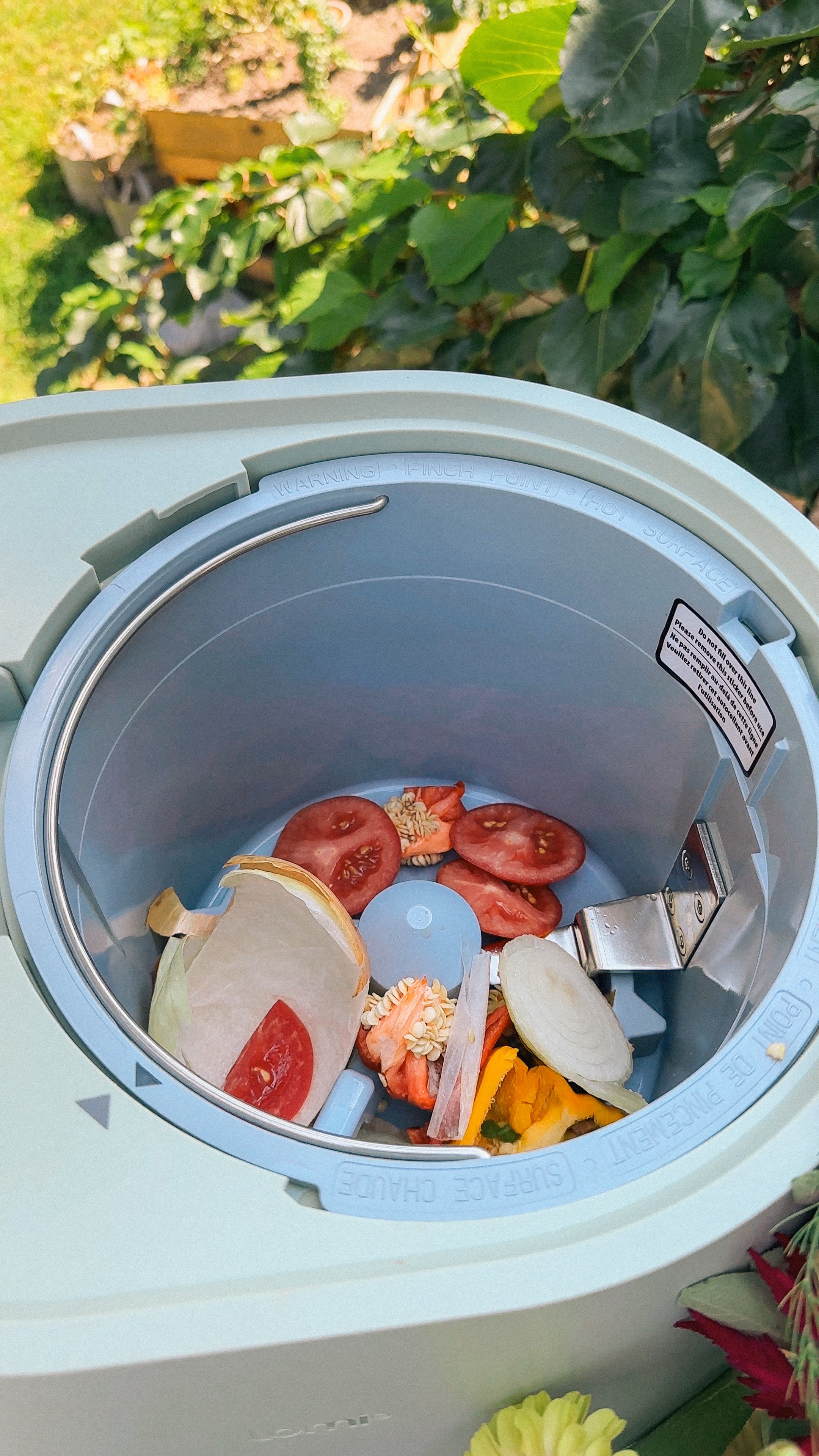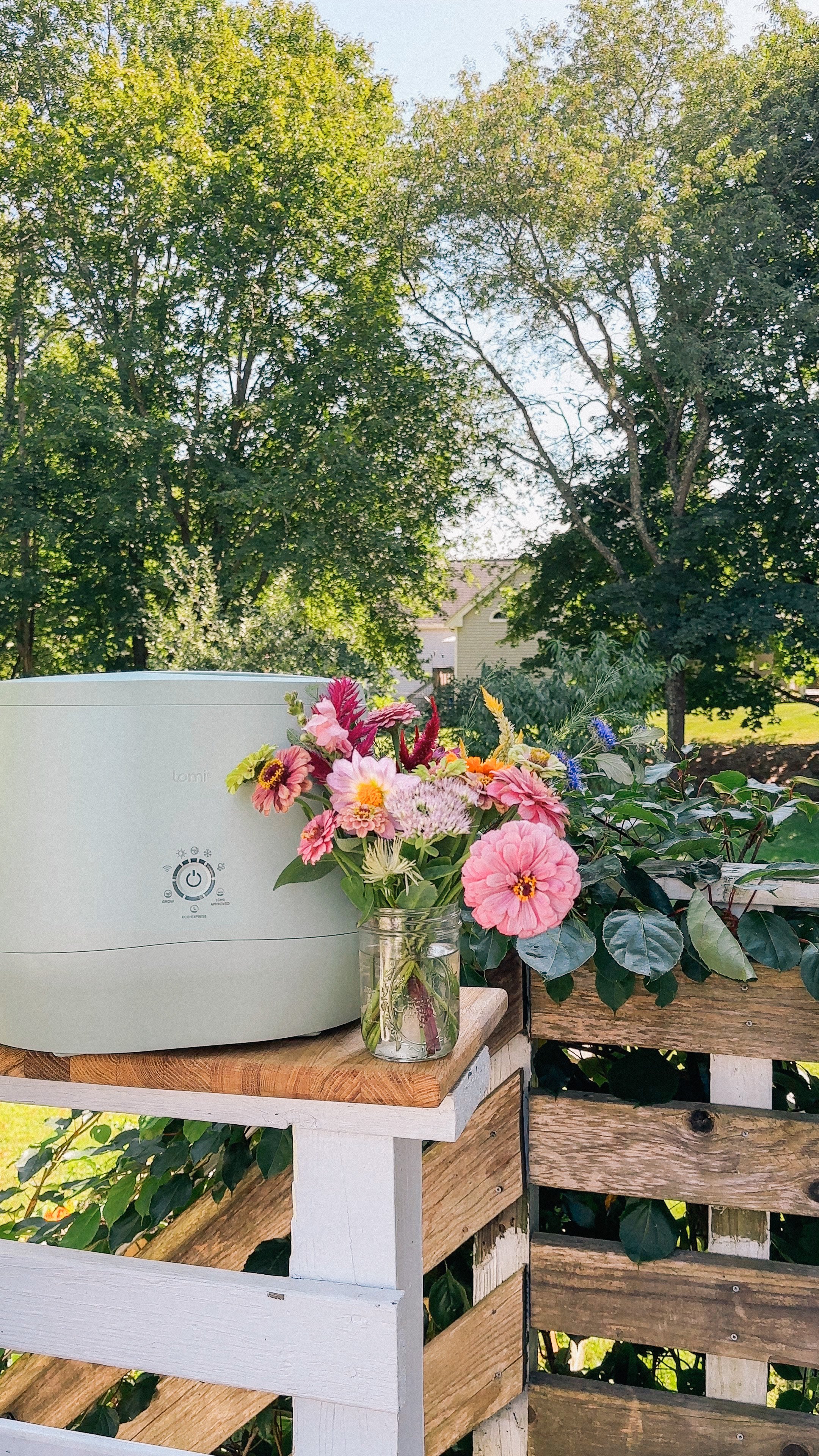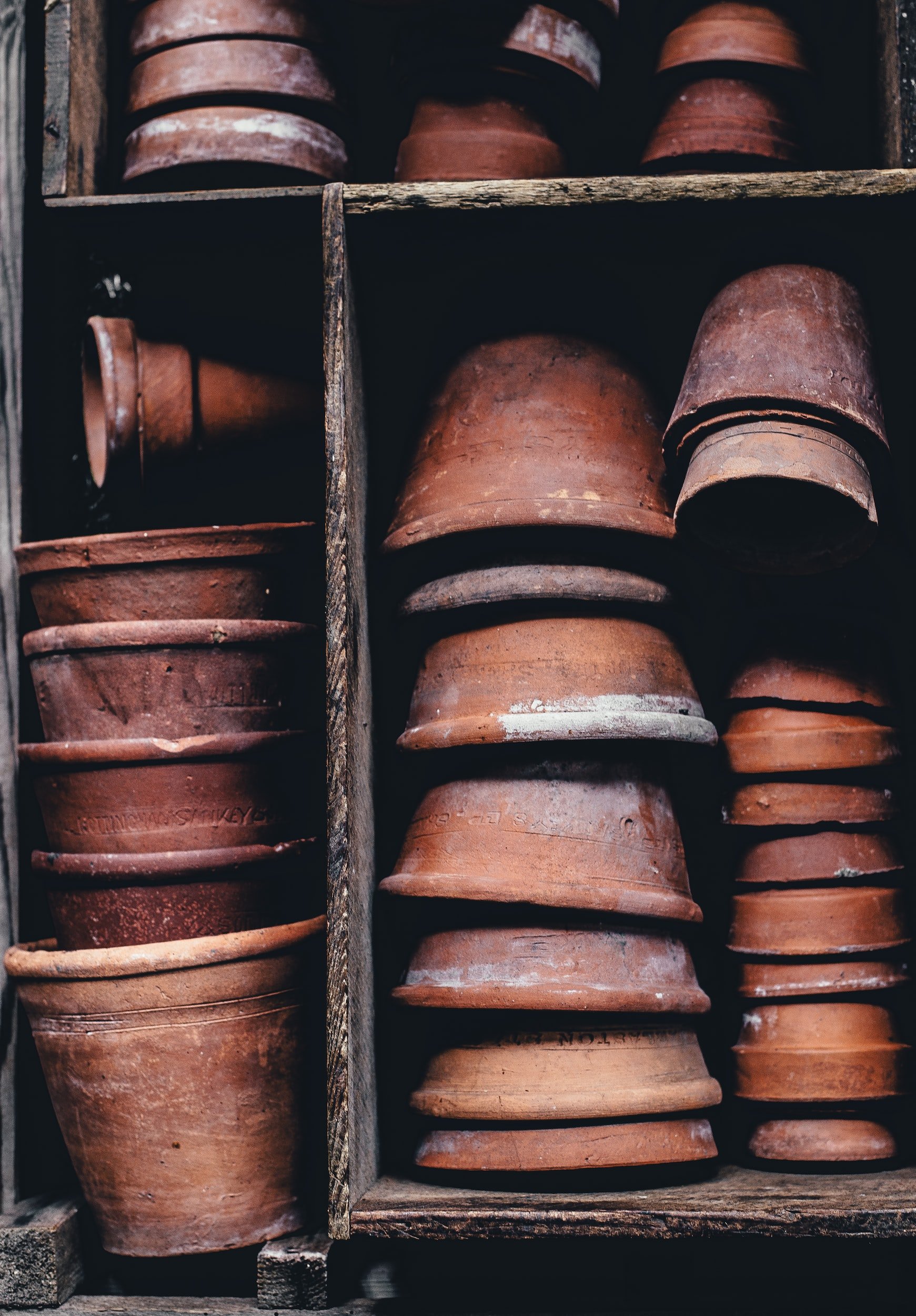BACKYARD GARDENING MADE SIMPLE
Composting for Beginners: Lomi Bloom Smartwaste Appliance Review
Lomi Bloom not only reduces your waste footprint, it also rewards you for getting rid of your waste the right way and enables you to actually track your impact and get rewarded for it. We all create food waste, but now - Lomi Bloom turns your trash into cash with Lomi Rewards. Earn points every time you run a cycle + redeem for free products from Lomi + other great brands. Save money on expensive store-bought fertilizer, reduce your carbon footprint, and get rewarded for upgrading the way you deal with waste.
The Cottage Peach is reader-supported. When you purchase through links on our site, we may earn an affiliate commission at no additional cost to you. All opinions are our own.
What is Composting?
Composting is a method of breaking down food waste and other organic matter into usable, nutrient dense soil by creating an environment which encourages decomposition through a microbial process. Composting creates a valuable fertilizer that can support and feed plant life. Most compost is made with a combination of kitchen scraps, paper, grass clippings, leaves, small twigs and brush, which when exposed to water, oxygen, heat, worms and other organisms create the conditions necessary for decomposition.
Benefits of Composting
So why should you compost? It all comes back to the kitchen.
24% of solid waste in landfills today is food waste, making it the most common material found in landfills
22% of solid waste that is incinerated is food waste
50% of the volume of waste that North Americans send to landfills each year is compostable materials.
80 billion pounds or 30-40% of the food supply is discarded every year in the United States.
Why does it matter if we waste food? Landfills are anaerobic and do not have the right conditions to properly break down food, and food waste in landfills releases methane, a potent greenhouse gas up to 36 times more effective than carbon dioxide at trapping heat in the atmosphere. In the harsh sunlight of the upper atmosphere, methane can react with other gasses to form water vapor, which then breaks down into other chemicals that destroy ozone.
Different Composting Methods
You can compost in many different ways, but the top three are:
Outdoor Composting Bin or Pile System
This is my preferred method because there is little to no set up cost, but it does require enough space for at least one 4x4 foot pile and must be manually turned in order to increase oxygen and encourage decomposition. You are also limited in the types of food waste you can put into your compost. This means no meat, dairy, eggs, citrus peels, fat or grease, and if you don’t have the space or energy this won’t be an option.
Tumbler Composting Barrel
This is a popular system with a moderate upfront cost which can be used even in more urban settings as long as you have some amount of land to work with. Since the compost is contained, the smell and sight won’t offend any neighbors and it is less likely to attract animals. You are also able to easily aerate the compost by turning a handle on the side of the barrel. Like the pile option, you are also limited in the types of food waste you can put into your compost. This means no meat, dairy, eggs, citrus peels, fat or grease.
Vermicomposting with Worms
Vermicompost is much higher in nutrients than the compost from a regular backyard composter, and takes less time to break down. Worms are also relatively cheap to purchase making this a lower cost option if you’re homesteading on a budget. You can also use this method both indoors and outdoors. Like the two options above, you are limited in the types of food waste you can put into your compost. This means no meat, dairy, eggs, citrus peels, fat or grease.
Electric Smart Waste Appliances like Lomi Bloom
These appliances transform your food-waste into nutrient-rich plant-food at the push of a button. While they aren’t inexpensive, Lomi Bloom is able to break down large quantities of food waste quickly and easily with no physical strain of turning the compost, and it’s small enough to fit on your counter. You can also break down many of the food items that cannot be composted using traditional composting systems. This makes Lomi Bloom the best choice for composting for beginners and renters who might not have an outdoor space of their own.
Lomi Bloom SmartWaste Appliance
Lomi Bloom is the best way to break down your food waste into nutrient rich Lomi Earth, ready to be incorporated into your garden soil or potted plants. Lomi Earth is a little different every time you run a cycle because it is composed of just your food waste (plus microbes and fungi from your LomiPod if you include that in the cycle). This diversity benefits your plants as they are exposed to a wide variety of beneficial organisms and minerals extracted from your food waste.
Pela, the company that created Lomi Bloom, calls the end product of Lomi Bloom nutrient-rich Lomi Earth instead of compost' or soil because both other terms have very specific qualities, including the amount of time it spent forming.
So how can a smart waste appliance reduce your carbon footprint? Pela did the research. With the help of third party audits, they found that despite the electricity consumed, Lomi Bloom can produce a net-lower carbon footprint than that same organic waste going to landfill.
Pela's primary goal is to improve the world's health by eliminating waste. They can't do that if the creation of Lomi Bloom negatively impacts the environment. So, they worked hard to ensure Lomi Bloom's production is carbon negative, and is proudly certified as a Climate Neutral company and B Corporation.
Did you know that 43% of food waste in the U.S. happens at the household level? The average American family loses $2,000 in food waste every year. Lomi wants to help you make some of that back… and feel a lot less guilty for what you throw out. Lomi Bloom not only reduces your waste footprint, it also rewards you for getting rid of your waste the right way and enables you to actually track your impact and get rewarded for it. We all create food waste, but now - Lomi Bloom turns your trash into cash with Lomi Rewards. Earn points every time you run a cycle + redeem for free products from Lomi + other great brands. Save money on expensive store-bought fertilizer, reduce your carbon footprint, and get rewarded for upgrading the way you deal with waste.
How Does Lomi Work?
Lomi basically chops up the food into smaller bits by grinding it, then uses heat to remove any moisture - making it a breeze for tiny organisms to start breaking down the waste. Grinding also gives the compost some air, boosting oxygen and setting the stage for microbes that love oxygen.
Lomi Bloom Review - Is the Lomi Worth it?
Pela generously sent me my very own Lomi Bloom to try in exchange for my honest review, and I’m extremely impressed with what Lomi can do. Not only do I have a ton of vegetable and fruit cutoffs from the garden to compost, I have eliminated the struggle of stinky dairy and meat scraps sitting in the trash for longer periods of time causing me to have to replace the bag sooner. Since I cold compost outdoors already, I know firsthand just how much composting reduces my household waste and was frustrated that I still had food I needed to throw in the landfill. Lomi Bloom is easy to set up, and all of the packaging can be composted in Lomi Bloom when you’re done. I just added the included carbon filtering material to the two filter cartridges inside of Lomi, plugged it in and it was ready to run its first cycle.
Lomi Bloom is about the size of an air fryer, but since you’ll most likely use it every single day you probably won’t want to store it in a cabinet - so depending on how much counter space you have this may be an appliance that you need to move things around to make room for. Lomi Bloom also needs about 6-12 inches of space on all sides since it does warm up a small amount when running. I store mine in the least used corner of my counters and just pull it out to give it space on all sides while it runs overnight. The design of Lomi Bloom and the sage green color fits right in with most kitchens.
Review of Lomi composter
There are three modes on Lomi Bloom, all controlled by the universal power button making this super user-friendly. Here’s what Pela has to say about the three modes:
ECO EXPRESS:
This is the best mode if you’re looking for fast results and low energy consumption.
What can go in
Eco-Express mode is for food scraps and plant waste. Do not put bioplastics or compostable commercial goods and packaging in this mode.
What to do with the result
Toss it into your home compost or green bin. Or add more fresh food scraps & run a Grow mode to create nutrient-rich Lomi Earth for your houseplants, garden and lawn.
LOMI APPROVED:
This mode is your solution for Lomi Approved non-food compostable waste. With smart sensors that control grinding, heat and moisture, this mode breaks down Lomi Approved bioplastics and compostable products much faster than a traditional compost.
What can go in
Mix plenty of plant & food waste with Lomi Approved bioplastics and compostable products - they recommend a maximum of 10% non-food waste in each cycle.
What to do with the result
Toss it into your green bin.
GROW MODE:
Grow mode runs longest and at a lower temperature to create the highest quality Lomi Earth -- a natural fertilizer that’s exactly what your plants crave!
What can go in
Grow mode is for fresh fruit & vegetable scraps and plant waste. Do not put bioplastics or compostable commercial goods & packaging in Grow mode.
What to do with the result
Toss it into your home compost, green bin or garden at a 1:10 ratio with soil. For best results in your garden, add more fresh food scraps & run a Grow mode to create nutrient-rich Lomi Earth.
How Often To Run Lomi
I run Lomi Bloom about 2-3 times a week, always on Grow Mode unless I have bioplastics, packaging or processed/cooked foods. Lomi Bloom is quieter than most dishwashers and washing machines, so I find that running it overnight (which is when I usually start my dishwasher anyway) fits right into my routine. When the cycle is complete, Lomi Bloom beeps and then enters standby mode if you do not open within 30 minutes. I’ve been amazed by how transformed my food waste really is - a stinky pail of the worst moldy leftovers is turned into a dare I say pleasant smelling final product that is ready for the garden.
Is Lomi Bloom loud?
Lomi makes noise comparable to other small countertop appliances which is less than 60 dB. It’s around the same or less than a coffee maker or modern dishwasher.
Can I Run Lomi More Than Once Before Emptying?
You can run up to 3 cycles without emptying your bucket! In fact, adding Lomi Earth from the last cycle will improve the quality of the next cycle’s end product. Simply add more fresh food waste on top and start the next cycle! Just be sure to empty the bucket after 3 cycles because too much will strain the grinder.
How Much Energy Does Lomi Use?
Lomi uses between 0.6 to 1.0 kWh per cycle, depending on the mode and cycle time. Cycle times range from 5 hours to 20 hours. In comparison to other appliances, each Lomi's cycle uses roughly the same amount of power required to operate an oven for 15 minutes.
What to do About Lomi Bucket Residue?
Avoid adding too many high sugar foods to Lomi as that can result in sticky residue. Always add a diverse mixture of food waste in each cycle.
How To Clean Lomi Bloom?
To clean stuck residue, wash the Lomi bucket with hot soapy water or run a Cleaning cycle. Do not submerge Lomi in water. Only the bucket is dishwasher safe and can be submerged.
What are LomiPods and why do I need them?
LomiPods are microbial compost accelerators, activated by 50ml of added water. They are carefully tailored to enhance soil quality for your plants. Using a LomiPod increases the number of microbes in Lomi Earth.
My Lomi is squeaking, what can I do?
Avoid adding too many high sugar foods to Lomi as that can result in sticky build up under the grinder and causes a squeaky sound as it turns. If this occurs, simply soak the inside of the bucket with hot soapy water to loosen the residue, then wipe it away.
Does Lomi Bloom Have a Warranty?
Here’s what you need to know about the Lomi warranty: Lomi comes with a standard 1-year warranty. The warranty is non-transferable and proof of purchase is required to claim.
Before Lomi Bloom, I had resigned myself to the awful smell of my regular compost bin seeping into my kitchen. Lomi Bloom’s odor-proof design and its ability to break down a wider array of organic waste than most methods has been life changing, Bottom line: Nobody likes trash. If you’re ready to take out the trash less often, reduce kitchen odors and your carbon footprint Lomi Bloom offers a hassle-free 14 day trial so you can see just how great Lomi is for yourself!
Track your impact and get rewarded with Lomi Bloom - Click Here to Visit Lomi.com.
10 Zero Waste Gardening Tools and Ideas
In all areas of our lives, from our hobbies to our habits, we have opportunities to either increase or reduce our impact on the environment and the effects of climate change. While the burden of fixing our climate crisis should not fall on the individual but the corporations that are responsible for the vast majority of damage done, every little bit you are able to do can help. The best part is, most of the ways we can reduce or eliminate our waste in gardening come at no additional effort or cost - it simply comes down to intentionally deciding on the plastic free or secondhand option instead (which is often cheaper anyway)
The Cottage Peach is reader-supported. When you purchase through links on our site, we may earn an affiliate commission at no additional cost to you. All opinions are our own.
In all areas of our lives, from our hobbies to our habits, we have opportunities to create or reduce our impact on the environment and the effects of climate change. While the burden of fixing our climate crisis should not fall on the individual but the corporations that are responsible for the vast majority of damage done, every little bit you are able to do can help. The best part is, most of the ways we can reduce or eliminate our waste in gardening come at no additional effort or cost - it simply comes down to intentionally deciding on the plastic free or secondhand option instead (which is often cheaper anyway)
What does zero waste mean? What is zero waste?
Zero waste is the principle or practice of sustainable living in which the participant commits to reducing or eliminating streams of waste in various aspects of their lives. This can include reducing water consumption, shopping the bulk food bins or repurposing household items at the end of their “useful” life, to name a few.
The concept of zero waste living can sound intimidating or difficult, but more often than not it is nothing more than a simple shift in your awareness and intention. It also does not mean you must completely eliminate all sources of waste in your life - despite the word “zero”, it is not an all or nothing game.
What kinds of waste are there?
Waste comes in all forms, in all areas of our lives. While the majority of waste filling landfills is produced by industrial operations, domestically, we waste food, water, energy, paper, packaging, furniture, clothes, computers, tires, appliances and more in unimaginable amounts. Americans send nearly 150 million tons of trash to landfills each year instead of recycling it, and we’re running out of space.
Where does waste go?
Waste goes into landfills, which typically cause the destruction of natural wildlife habitats in their construction. They are often lined in plastic. The average landfill size is 600 acres. With over 3,000 active landfills in the United States, as much as 1,800,000 acres of habitat have been lost. When waste breaks down in a landfill, methane gas is released. Methane is 84 times more effective at absorbing the sun’s heat than carbon dioxide, making it one of the most potent greenhouse gases and a huge contributor to climate change.
Food can’t break down in a landfill
Food waste needs oxygen in order to break down properly. Due to the fact that landfills are so tightly packed with waste of all kinds, food waste is often suffocated to the point where it cannot break down into the individual nutrients it is composed of and be reabsorbed into the earth, regenerating the soil. What happens if food doesn’t break down? It rots. When food rots in a landfill, it produces huge amounts of methane — a greenhouse gas at least 28 times as potent as carbon dioxide.
Here’s what the FDA has to say about the impacts of food waste:
“Food loss and waste is estimated to be roughly one third of the food intended for human consumption in the United States. When food is discarded, all inputs used in producing, processing, transporting, preparing, and storing discarded food are also wasted. Food loss and waste also exacerbates the climate change crisis with its significant greenhouse gas (GHG) footprint. Production, transportation, and handling of food generate significant Carbon Dioxide (CO2) emissions and when food ends up in landfills, it generates methane, an even more potent greenhouse gas.”
This is why zero waste food is so important, and we can do this easily with composting! (More information on that below)
Ways to incorporate zero waste principles into your garden
We live in an era that romanticizes convenience in all forms. Of course it’s easy to see where these ideas might apply to a zero waste home, but this also extends to our hobbies, including gardening. You can’t visit the local garden center without being bombarded with gadgets and tools promising to make garden tasks easier, faster or better. But the fact is that humans have been gardening successfully for hundreds of years, without many of these interventions. Certainly there are tools that make gardening more accessible for those of us with chronic illness or pain that find it challenging, but here I’m primarily referring to situations where there is a perfectly good alternative with less packaging, that is made without plastic which can never break down once it reaches the end of its useful life.
I’m sure you’ve heard this before, but the key concepts behind achieving a zero waste lifestyle are to reduce, recycle and repurpose. But how do you apply these concepts in the garden?
I recommend intentionally shifting your mindset.
When something breaks and needs to be replaced in the garden, first ask yourself “Can this be repaired?” if not, ask “can it be repurposed?” and if you still cannot find a use for the broken item, ask “can it be recycled?”
With these three simple questions, you’ll be well on your way to intentionally incorporating zero waste practices into your garden routine. But here’s a few ideas for zero waste gardening to get you started:
Reuse food containers for produce storage
Pop your zucchini in an old bread bag, pureed pumpkin in salsa jars and fresh picked berries in plastic yogurt tubs - all of which make excellent replacements for disposable freezer bags or plastic wrap. You’re keeping those items out of the waste stream AND preventing the addition of another piece of waste from the disposable products you skip using.
Wrap produce in damp cloths
Not only are you avoiding the use of disposable cling wrap, you’ll extend the life of your vegetables and avoid having to send them to the compost all together. In fact, learning the best storage methods for every fruit or vegetable that you grow is the best way to reduce food waste.
Save shower water for plants
Before you close this page in disgust, I’m not saying you have to save your DIRTY shower water. But how long are you running that shower before you even get in? Simply place an empty 5 gallon bucket under the faucet until you’re ready to get in, then pour that excess water on your garden beds when you go out to water.
Make vegetable stock
By being proactive and saving any cut offs from your carrot and onion ends, as well as any whole vegetables you won’t be able to use before they go bad and freezing until you have a full gallon bag to work with you can make simple and nutritious vegetable stock - just add your collected scraps to a pot of boiling water and simmer covered for 1-4 hours.
Compost
Landfills lack the oxygen that compostable items need to fully decompose. By putting biodegradable items into the compost instead of the trash, you can save huge amounts of waste from the landfill. We have an outdoor compost pile as well as Lomi - an indoor countertop composter that allows us to compost all sorts of things we couldn’t put in a regular compost pile including meat, dairy and bioplastic packaging which would take years to fully decompose in a traditional compost pile.
Save cardboard for kindling/weed barrier
Any child who has ever built a fort out of a box will tell you that cardboard has infinite uses, and the garden is no exception.
Buy second hand garden clothing/tools
When you choose second hand gardening tools, hats and aprons you’re keeping precious items from the landfill, giving them a new life and best of all these items have generally already withstood the test of time, so you can count on them to last.
Take care of what you have to make tools last
Once you have those second hand tools, make sure and do your research on the best way to maintain them. Click here for my post all about the best ways to maintain your gardening tools.
Repurpose branches for stakes/trellis
Nobody likes a plastic trellis, and even the pretty wooden ones available at garden centers hardly last me one season. Building a natural trellis using sticks and branches is simple and rewarding, and fits in well with the natural landscape you’re working in. Plus, at the end of the year you can just chuck them back in the woods if they’re broken or place aside to reuse again.
Use jute twine instead of nylon
According to GoodOnYou, producing nylon creates nitrous oxide, a greenhouse gas that is 300 times more potent than carbon dioxide…Manufacturing nylon is a very thirsty process; large amounts of water are used for cooling the fibers, which can be a source of environmental contamination and pollution. Treehugger says that nylon production is associated with the same negative environmental impacts as fossil fuels, including exacerbating the climate crisis. It’s safe to say that nylon is definitely not biodegradable, unlike its natural cousin jute twine. Because jute is compostable and biodegradable and requires fewer resources to grow and produce, it is considered a future-proof sustainable fiber.

